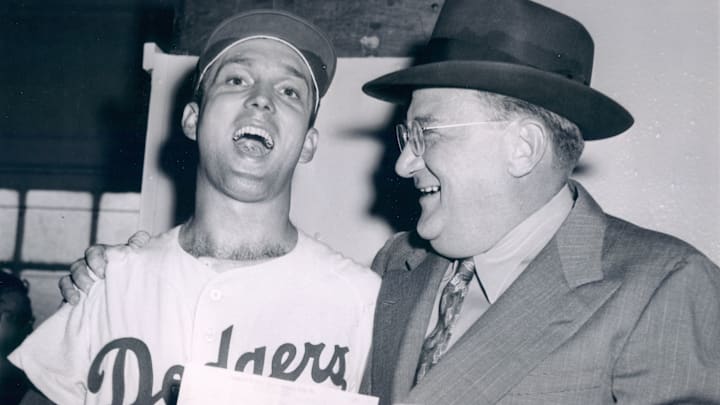Carl Erskine was far more than just a professional baseball player.
In more ways than one. In the granular sense, he was likely known by more people as an agent of social change than as someone who threw a round ball for a living. By virtue of the amount of time he received on this earth, he interacted with and impacted a larger swath of humanity as a post-career advocate than he did wearing a Dodgers uniform.
But, then again, in a more ethereal sense, the Brooklyn Dodgers of the 1940s and 1950s were far more than just baseball players. Erskine the man sowed more oats as a father of a son with down syndrome, a Special Olympics advocate, and an ongoing overseer who helped Negro League players receive medical and financial assistance as an advisory board member with the Baseball Assistance Team.
Erskine the Brooklyn Dodger? He'll live forever. He'll eternally be a part of the fabric of a borough, a place where the baseball story ends with Erskine (and Pee-Wee, and Jackie, and Ralph, and Gil) nearly 70 years ago.
It's impossible to determine where and in what manner Erskine managed to positively impact more souls during his 97 years of glorious life. In the end, the guiding light of his story remains that he was hugely impactful, in every way he could be, as a metaphor and a healer, as a hand-holder and a curveball artist, for the duration.
How can we measure a man when our ancestors have already done it for us, in more powerful language than we ever could?
Rest in peace “Oisk” - Carl Erskine.
— Brooklyn Cyclones (@BKCyclones) April 16, 2024
One of Brooklyn’s favorite Boys of Summer will be deeply missed and never forgotten. pic.twitter.com/G7uxR3rAxI
Brooklyn -- and Dodgers -- icon Carl Erskine dies at 97
Dem Bums, those pesky Boys of Summer, the team that prevented the Dodgers from leaving a generation behind on the East Coast without a championship to their name, earned their title two years before the final game played at Ebbetts Field. It was a seven-gamer, won over their crosstown rival Yankees on enemy turf, the final game won 2-0 on the right arm of Johnny Podres. Hilda Chester and her cowbell could be heard all the way from Flatbush. Walter Alston ushered the uproariously giddy Dodgers back to the visiting clubhouse, where a madcap celebration ensued -- a celebration that wasn't supposed to define the next seven decades, but would have to do. It would have to be enough for Brooklyn's grandfathers, patting young boys on the back without knowing there wouldn't be many more "next times" in which to get 'em.
Erskine started one game in that series, allowing three earned runs in three innings of work. He started twice in 1952 as a 25-year-old, and twice more in 1953. He took the ball in 1956, unable to help his hallowed team defend their singular and indelible title. He traveled to Los Angeles with his brothers in 1958, but was out of baseball after 1959 at the age of 32. Arms were different in those days. It's not necessarily that pitchers "break down more" now; it's that, when they broke down in 1959, they were gone forever.
Except Erskine. His life was just beginning.
Until April 16, 2024, Erskine, the Indiana native and the piece of Brooklyn iconography, was one of two living 1955 Dodgers. The other one? You might've heard of Sandy Koufax, who learned where his fastball was going only after switching coasts.
Koufax, without his sea legs under him just yet, did not pitch in that 1955 World Series for his hometown team. Erskine took the ball, and then continued to take it for 69 years afterward. Whenever someone needed context for the modern marks of racial injustice from a man who facilitated integration of the Major Leagues up close, Erskine was ready and willing to talk. Whenever a child wasn't being afforded the opportunities he or she deserved because of their genetics, Erskine was prepared to help blaze a trail and clear the brush. And whenever a forsaken east coaster wanted to reminisce about the men who raised them, outside the household, Erskine was a beacon.
And may he continue to burn brightly, no matter which era of his advocacy and symbolic grace touched you most.
